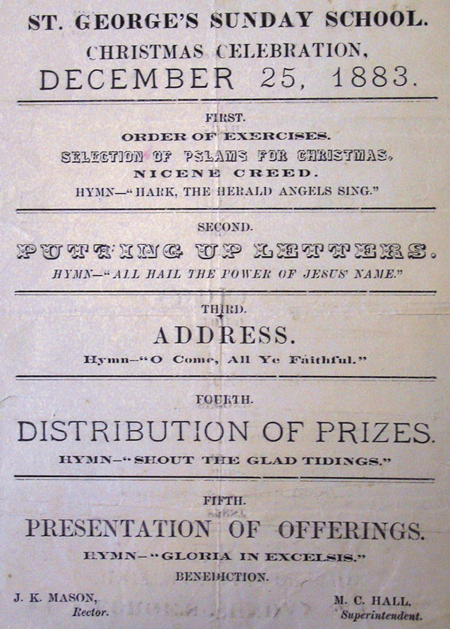
Most of the church bulletins in our archives are post 1970’s. One exception is the one below from 1883 which is wonderfully preserved.
Christmas from at least the 1880’s through the 1920’s featured only one Christmas Eve service which was a Sunday School celebration around 7pm with a single service at 11am on Christmas day. Other Protestant churches also featured Sunday School celebration, and some like the Baptists and Methodists held them on Christmas day. The “Midnight” services appeared by the 1920’s but not at St. George’s.
The 11am service on Christmas day was Holy Communion (as opposed to Morning Prayer) and featured music that would be part of Christmas Eve services today. In 1911 the service was published ahead and included “Shout the Glad Tidings”, two chants (Venite, Gloria), Te Deum, Jubilate, Hymn 49, Gloria Tibi, Hymn 59, and an offertory “Sing O Heavens.”
Local papers (Daily Star, Free-Lance) publicized the Sunday School celebrations days in advance, many years on page 1, and provided elaborate reviews of several of the local church services a few days later inside the paper.
Typical is the review of the 1886 service, held 7pm on December 24: “Promptly at the appointed hour named the appointed Scholars assembled in the basement room where they were formed into line and marched to the body of the Church, each class bearing an appropriate banner. As the Scholars entered headed by their efficient superintendent Mr. Hall, the organ gracefully and ably presided by Miss Hattie Slaughter pealed forth the beautiful hymn led by Mrs. Dr. Doggett and Mrs. W. E. Bradley who had charge of the music, the children joining in the singing with the choir filled the room with their happy voices. After singing several beautiful and appropriate hymns and a few remarks by the Rector Rev. Mr. Mason the Scholars entitled to prizes were called to the chancel and received their prizes.” The banners contained “Glory to God in the Highest”, “Faith, Hope and Charity”, “Hark the Herald Angels Sing”, “Children of the Resurrection” and “Children of the Resurrection.” Calling the children “Scholars” lasted until the early 1920’s.
The description in 1888 mentioned a prize for bringing in the greatest number of “scholars.” (There were 175 in the Sunday school including officers, teacher and scholars). Prizes would also be awarded both attendance and merit. During the service, one from each class marched to the Chancel railing to present a Christmas offering. Typically, as they returned to their seats the doxology was sung. Toward the end they marched around and out by the side aisles and down to the Sunday school rooms (Sydnor Hall) for treats. “When the usual amount of goodies have been heaped into a large pyramid of bright tarlatan bags, dressed with holly, ivy and vines surmounted by a row of different colored candles, the sight of which the bright and happy faces made us wish we were children again.” By 1900, there was a special banner held by one of the classes for the entire year.
In reviewing the services, we would know many of the hymns. They usually started with “Hark the Herald Angels Sing” (more typically today toward the conclusion of the service) and ended with “Angels from the Realms of Glory”, a trend that was continued into the 1930’s. “Silent Night” was sung with a kneeling congregation.” Several within the service are not sung today – “Ring the Merry Christmas Bells”, “Shout the Glad Tidings (in the 1940 hymn and dropped out in 1982), “A Little Child Shall Lead Them”, “When Christ was Born of Mary Free.”
The shift in services appeared to begin in the 1920’s. The Sunday School celebration gave way to what was termed “tableaus” or scenes but not yet plays. In 1930, it was the wise men and the children would come up to present their gifts. In 1940, there were two – “Invitation to Come to Bethlehem” and “the Nativity.” Children also began to participate in the choirs, notably the “Junior Choir” which began to be featured.
By the 1920’s, there was also an effort to remember the needy. “Upon entering the Church the entire procession first passed by a large cradle where deposited a gift of provisions, clothing, fruits, etc for the relief of the poor of this community.” An offering was taken up “for the relief of suffers in the Near East.” In 1935, there were toys collected for 700 needy children in Fredericksburg. 300 pounds of candy, oranges and other fruits were collected.
The Christmas play would appear in the 1920’s and 1930’s led by Elsie Lewis, from the mid-twenties through 1950, and who was the assistant superintendent and then superintendent of Sunday schools. The play was revived in 1982 and continues to this day.
Late evening services are mentioned in four churches in 1930 along with the morning service at St. George’s with Holy Communion. In 1934 and 1936 a community services were scheduled. In 1936, it involved ministers and congregations of six local churches.
The newspapers descriptions not only presented the events of the services but also a glimpse of details of the church and how it was decorated. In 1877, “the desk of the pulpit, the reading desk and railing of the chancel were covered with evergreens. The panels of the gallery were adorned with the following text in letters of evergreen – ‘the fir tree, the pine tree and the box together beautify the place of my sanctuary.’ The massive pillars were wreathed and the panels in the walls were adorned with anchors and crosses.” One article in 1922 commented on the Church’s Christmas decorations: “The beautiful old church was handsomely decorated for the Christmas season with cedar, evergreen, holly and palms and though large, every pew was filled by the school and the congregation.”
